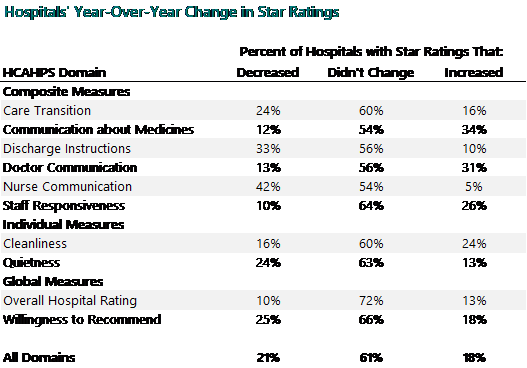Jun 18
2019
Improving HCAHPS Star Ratings: Insights From the Ascom HCAHPS Database
By Chris Talbot, senior vice president of marketing and business development, Ascom.

More than 4,900 U.S. hospitals participate in the Hospital Consumer Assessment of Healthcare Providers and Systems Survey (HCAHPS), including 3,529 that received star ratings in the most recent quarterly update. These ratings reflect an effort by the Centers for Medicare & Medicaid Services (CMS) to help consumers make informed choices about their care, putting more decision-making and purchasing power in their hands.
Because star ratings are expected to play an increasing role in helping consumers choose hospitals, it is important to understand these metrics and what hospitals can do to improve their performance.
Toward that end, Ascom created a comprehensive, time series database of hospital HCAHPS performance.
Changes to hospital Star Ratings over time
Leveraging our database, we conducted a year-over-year analysis of star ratings for all participating hospitals, providing insights into how star ratings change over time as well as clues to what it may take to improve performance.
As shown in the table below, our analysis revealed that star ratings tend to be sticky. In our year-over- year comparison across all hospitals, 61 percent of ratings remained unchanged. Overall, only 18 percent of ratings improved over a 12-month period, while 21 percent declined.

Why Star Ratings are slow to change
There are two main reasons that hospitals’ star ratings tended not to change over a 12-month period.
- Because the quarterly HCAHPS results include four quarters’ worth of survey data, it can take a while for improvements to show up in the ratings. Even if a hospital achieves significant improvements in its most recent quarter, that quarter’s results are combined with the previous three quarters’ poorer results when they are reported by CMS.
- There is also the difficulty of the task at hand. It’s not just a matter of providing excellent patient care – which is difficult enough; it’s also a matter of providing this level of care at the highest level of consistency.
Consistency is the key to improvement
Consistency is important at two levels. The first is across the HCAHPS domains. While HCAHPS monitors several different individual domains such as care transition, cleanliness, etc., they all add up to a total experience across each individual patient’s journey.
Our correlation analysis between all the linear mean scores for all HCAHPS domains found that if a patient’s satisfaction with one domain was high, then satisfaction with all domains tended to be high and vice versa. This in turn drove overall satisfaction with the hospital, and patient likelihood to recommend the hospital to others.
The second level is consistency within the domains.
When we isolated the hospitals that have succeeded in improving their star ratings over 12 months, we found that these improvements were driven by significant improvements in their top box scores. In most cases, these top box scores are earned when patients indicate that the hospital always met standards – and most hospitals already have high top box scores.
The role of clinical communications technology
Consistent patient experiences are only possible if caregivers have access to interoperable communications technology that seamlessly, consistently and accurately delivers timely information across the patient journey, while at the same time helping them to efficiently manage their workflows.